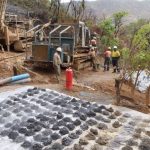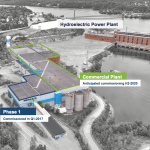LG Chem: Storage Battery Leader
by Debra Fiakas CFA The post “Energy Storage Restart,” which was published last week, discussed the efforts by General Electric (GE: NYSE) to get back into the market for utility-scale energy storage. After some difficulties that required the partial closing of its battery manufacturing plant, GE has got back in the game with new contracts wins. In April 2015, the company won a contract to supply Con Edison Development with an 8-megawatt-hour battery storage system at a solar project in California. GE will be integrating lithium-ion batteries rather than...
Canadian and Tanzanian Graphite Connections
A list of graphite companies covered in this series can be found here.
Like performance test results, customer relationships are critical stepping stones for graphite developers. In June 2018, Northern Graphite (NGC: TSX-V) announced a memorandum of understanding with a European trading company to sell 100% of the output from Northern’s Bisset Creek resources in Ontario, Canada. China-based manufacturers are the intended end-users. Northern management is using the arrangement as leverage with prospective investors to finance mine infrastructure and processing equipment. Capital costs are expected to exceed CA$145 million.
Northern claims a proprietary purification technology the company intends to use to upgrade its graphite output. Its Bissett Creek deposit...
Batteries for HEVs, Batteries for EVs
I'm a longtime fan of electric vehicles (EVs) as well as Plug in Hybrid Electric Vehicles (PHEVs), in all their variations. When it comes to investing, I think the best way to invest in on the growth of electric transportation is batteries, partly because pure play battery companies exist (although my top battery pick, Electro Energy (EEEID) , has been one of my poorest performers, in a classic case of a cheaply priced company getting even cheaper. Given these interests, I was speaking to the President of Porous Power Technologies, a private battery components firm a couple weeks ago...
Nemaska Sprints to Early Lead In Lithium Mining Race
Thank Elon Musk with his Tesla (TSLA) gigafactory for sparking a global obsession with lithium-ion batteries and the materials need to turn them out. Claimed by Musk to be the largest building in the world, the factory was planned to reach capacity in stages. By the time the factory is fully completed in 2020, production capacity is expected to be 150 gigawatt hours of battery packs.
Ever since construction of Musk’s gigafactory began in 2014, investors around the world have been fretting over the adequacy of lithium supplies in particular. The gigafactory concept appeared to trigger a whole slew of ‘me too’ factories...
EVs, Batteries and Tales From The Valley of Death
John Petersen Today is the fourth anniversary of my blog on investing in the energy storage and electric vehicle sectors. Over the last four years I've penned 275 Articles and 45 Instablogs on topics ranging from technical minutiae to broad macroeconomic trends. Since most of my work focuses on challenges and risks instead of lofty and optimistic goals, I'm often derided as a curmudgeon who doesn't understand the dream. Truth is I've been a guide in the Valley of Death for over thirty years and while I love panoramic scenery, I can't overlook the dangers of old mine...
Hype Busters From Lux Research Explain Grid Based Energy Storage
John Petersen In 1883 Thomas Edison said, "The storage battery is one of those peculiar things which appeals to the imagination, and no more perfect thing could be desired by stock swindlers than that very selfsame thing. ... Just as soon as a man gets working on the secondary battery it brings out his latent capacity for lying." The problem isn't so much the batteries, which haven't improved all that much over the last century. Instead, the problem lies in the fertile imaginations of scientists, engineers, politicians, ideologues, analysts and investors who focus on new energy...
The Coming Bull Market In Lead-Acid Batteries, Part II
John Petersen On June 8th Switzerland's ABB Group Ltd. (ABB) announced an agreement to buy UK-based Chloride Group PLC (CHLD.L) for £860 million in cash, or approximately $1.26 billion. This stunning purchase provides the best evidence yet that lead-acid battery manufacturers including Enersys (ENS), Exide Technologies (XIDE) and C&D Technologies (CHP) are woefully undervalued and offer outstanding opportunity for patient and risk tolerant investors. ABB is the gold standard in the secure and efficient generation, transmission, distribution and use of electricity in utility, industrial and commercial applications. Its portfolio ranges from light switches to robots, and from...
Tesla’s Gigafactory: Guessing Games
James Montgomery Tesla Motors (NASD:TSLA) made a splash last week with its proposed $5 billion "Gigafactory" and its eye-popping numbers: a 10 million square foot facility on an entire land area of 500-1,000 acres, with output of 35 GWh/year of battery cells and 50 GWh/year of battery packs by 2020. That'll be enough to support 500,000 of the company's forthcoming Gen-3 vehicles, compared with a little over 20,000 annual demand for its cars today. By comparison, the entire lithium-ion battery supply-chain produced about 34 GWh in 2013, the vast amount going not to electric vehicles but consumer electronics....




